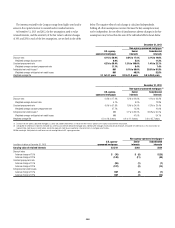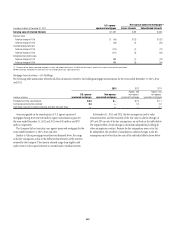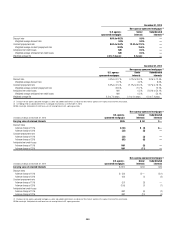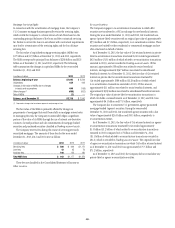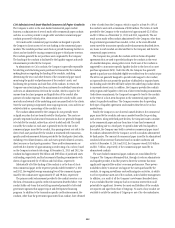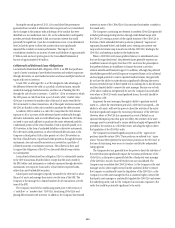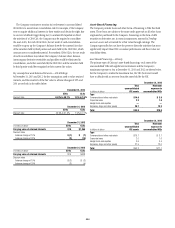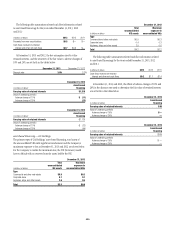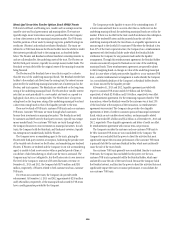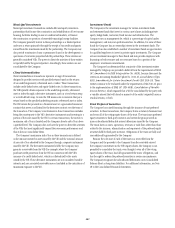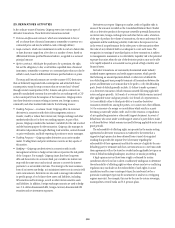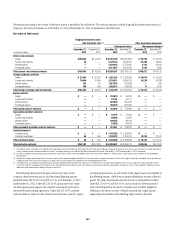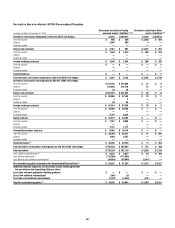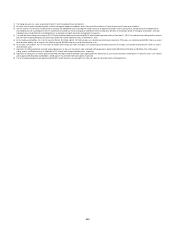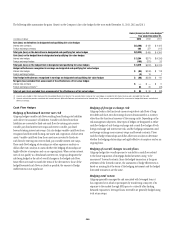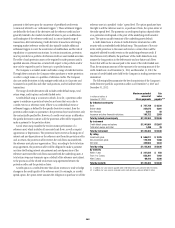Citibank 2013 Annual Report Download - page 276
Download and view the complete annual report
Please find page 276 of the 2013 Citibank annual report below. You can navigate through the pages in the report by either clicking on the pages listed below, or by using the keyword search tool below to find specific information within the annual report.258
23. DERIVATIVES ACTIVITIES
In the ordinary course of business, Citigroup enters into various types of
derivative transactions. These derivative transactions include:
• Futures and forward contracts, which are commitments to buy or
sell at a future date a financial instrument, commodity or currency at a
contracted price and may be settled in cash or through delivery.
• Swap contracts, which are commitments to settle in cash at a future date
or dates that may range from a few days to a number of years, based on
differentials between specified financial indices, as applied to a notional
principal amount.
• Option contracts, which give the purchaser, for a premium, the right,
but not the obligation, to buy or sell within a specified time a financial
instrument, commodity or currency at a contracted price that may also be
settled in cash, based on differentials between specified indices or prices.
The swap and forward contracts are over-the-counter (OTC) derivatives
that are bilaterally negotiated with counterparties and settled with those
counterparties, except for swap contracts that are novated and “cleared”
through central counterparties (CCPs). Futures and option contracts are
generally standardized contracts that are traded on an exchange with a CCP
as the counterparty from the inception of the transaction. Citigroup enters
into these derivative contracts relating to interest rate, foreign currency,
commodity and other market/credit risks for the following reasons:
• Trading Purposes—Customer Needs: Citigroup offers its customers
derivatives in connection with their risk-management actions to
transfer, modify or reduce their interest rate, foreign exchange and other
market/credit risks or for their own trading purposes. As part of this
process, Citigroup considers the customers’ suitability for the risk involved
and the business purpose for the transaction. Citigroup also manages its
derivative risk positions through offsetting trade activities, controls focused
on price verification, and daily reporting of positions to senior managers.
• Trading Purposes—Citigroup trades derivatives as an active market
maker. Trading limits and price verification controls are key aspects of
this activity.
• Hedging—Citigroup uses derivatives in connection with its risk-
management activities to hedge certain risks or reposition the risk profile
of the Company. For example, Citigroup issues fixed-rate long-term
debt and then enters into a receive-fixed, pay-variable-rate interest rate
swap with the same tenor and notional amount to convert the interest
payments to a net variable-rate basis. This strategy is the most common
form of an interest rate hedge, as it minimizes interest cost in certain yield
curve environments. Derivatives are also used to manage risks inherent
in specific groups of on-balance-sheet assets and liabilities, including
AFS securities and borrowings, as well as other interest-sensitive assets
and liabilities. In addition, foreign-exchange contracts are used to hedge
non-U.S.-dollar-denominated debt, foreign-currency-denominated AFS
securities and net investment exposures.
Derivatives may expose Citigroup to market, credit or liquidity risks in
excess of the amounts recorded on the Consolidated Balance Sheet. Market
risk on a derivative product is the exposure created by potential fluctuations
in interest rates, foreign-exchange rates and other factors and is a function
of the type of product, the volume of transactions, the tenor and terms of the
agreement and the underlying volatility. Credit risk is the exposure to loss
in the event of nonperformance by the other party to the transaction where
the value of any collateral held is not adequate to cover such losses. The
recognition in earnings of unrealized gains on these transactions is subject
to management’s assessment as to collectability. Liquidity risk is the potential
exposure that arises when the size of the derivative position may not be able
to be rapidly adjusted at a reasonable cost in periods of high volatility and
financial stress.
Derivative transactions are customarily documented under industry
standard master agreements and credit support annexes, which provide
that following an uncured payment default or other event of default the
non-defaulting party may promptly terminate all transactions between the
parties and determine a net amount due to be paid to, or by, the defaulting
party. Events of default generally include: (i) failure to make a payment
on a derivatives transaction (which remains uncured following applicable
notice and grace periods), (ii) breach of a covenant (which remains uncured
after applicable notice and grace periods), (iii) breach of a representation,
(iv) cross default, either to third-party debt or to another derivatives
transaction entered into among the parties, or, in some cases, their affiliates,
(v) the occurrence of a merger or consolidation which results in a party
becoming a materially weaker credit, and (vi) the cessation or repudiation
of any applicable guarantee or other credit support document. An event of
default may also occur under a credit support annex if a party fails to make
a collateral delivery (which remains uncured following applicable notice and
grace periods).
The enforceability of offsetting rights incorporated in the master netting
agreements for derivative transactions is evidenced to the extent that a
supportive legal opinion has been obtained from counsel of recognized
standing that provides the requisite level of certainty regarding the
enforceability of these agreements and that the exercise of rights by the non-
defaulting party to terminate and close-out transactions on a net basis under
these agreements will not be stayed or avoided under applicable law upon an
event of default including bankruptcy, insolvency or similar proceeding.
A legal opinion may not have been sought or obtained for certain
jurisdictions where local law is silent or sufficiently ambiguous to determine
the enforceability of offsetting rights or where adverse case law or conflicting
regulation may cast doubt on the enforceability of such rights. In some
jurisdictions and for some counterparty types, the insolvency law for a
particular counterparty type may be nonexistent or unclear as overlapping
regimes may exist. For example, this may be the case for certain sovereigns,
municipalities, central banks and U.S. pension plans.


